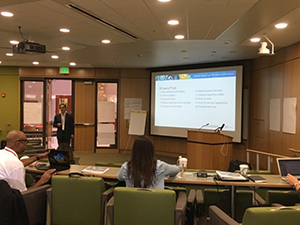
Originally published on Valley Vision
In order to support the needs of the regional workforce, community college leaders must establish close connections with business and community partners. Likewise, business and community partners must work closely with community colleges to ensure the courses and curriculum offered are providing students with employable skills upon graduation. But what are the key elements of a successful partnership?
On March 29th and 30th, Valley Vision participated in a workshop on strengthening community colleges through civic stewardship at Stanford University. The workshop was sponsored by the Stanford Educational Leadership Initiative in partnership with California Forward and the California Community Colleges Vice Chancellor for Workforce and Economic Development. Civic leaders from across the state, including members of the California Stewardship Network (CSN), traveled to Stanford to learn how to better partner with community colleges to meet the workforce needs within their regions.
With their ability to train workers with job-ready skills that employers need, community colleges have been identified as key drivers to fuel regional economies and enable social mobility. Yet community colleges leadership face multiple constraints including inability to hire and fire at will, decision making by consensus, and responsibility to an elected board of trustees. Community colleges also serve a much more diverse student body than typical 4-year colleges: the average age of students across community colleges in California is 29-years, and more than half of the student population at community colleges are students of color. Community college students are often the first in their families to attend college. These students may need more support in navigating college enrollment and pathways to employment, yet the community colleges receive less funding per student than the California State University or University of California systems.

Five key steps for successful cross-sector partnerships were identified. First, the partners must identify a common agenda – a shared vision for change. This first step ensures the partners are in sync and headed in the same direction. Shared accountability based on common metrics must also be established to keep the partnership on track. Engaging in mutually reinforcing activities is the third step. For example, embedding work-based training experiences into the curriculum would serve this purpose. Consistent and intentional communication is another critical step. Educators and industry truly do speak different languages. Regular communications and understanding of the others constraints and points of view are a must for successful partnerships. The final critical step is working with a convening organization to bring cross-sector partners together. Community colleges or a community partner organization may serve as a convener to bring partners together and provide the opportunity to share information and work toward common goals.
California Community Colleges are making a major investment in Doing What Matters for Jobs and the Economy. The State is also making a major investment in the Strong Workforce program. With these investments, California is well positioned to advance social mobility and produce a skilled workforce to fill the demand for nearly one million middle skill jobs. Civic stewardship of our community colleges is required in order to ensure that they continue to serve as a gateway of opportunity for Californians today and tomorrow. This will not happen without robust cross sector partnerships.
Be sure to stay up-to-date with Valley Vision’s work to build a 21st Century Workforce across the Sacramento region.
Tammy Cronin is a Valley Vision Project Leader working in the workforce development and broadband portfolios.

